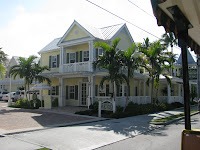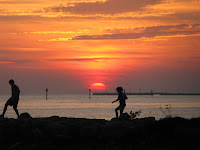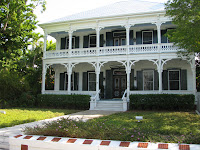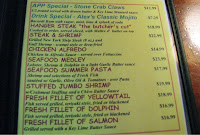The Florida Keys... what an experience!
 The adventure begins with the first bridge off the mainland and the bright sun reflecting off the sky blue jersey barriers and bridge walls. I've never seen painted barriers before! Traveling Highway 1, the only road to Key West needs 2-4 hours(or more depending on traffic and drivers). We had just started when the traffic merged and stopped. Today was...paint the white shoulder line day! The paint truck filled most of the two lanes. A car could carefully squeeze by, however the motorhome a few cars ahead of us would tear up his rig if he tried. Finally the spotter decided that enough traffic had back up and he had the paint truck pull off the road and let the traffic jam pass.
The adventure begins with the first bridge off the mainland and the bright sun reflecting off the sky blue jersey barriers and bridge walls. I've never seen painted barriers before! Traveling Highway 1, the only road to Key West needs 2-4 hours(or more depending on traffic and drivers). We had just started when the traffic merged and stopped. Today was...paint the white shoulder line day! The paint truck filled most of the two lanes. A car could carefully squeeze by, however the motorhome a few cars ahead of us would tear up his rig if he tried. Finally the spotter decided that enough traffic had back up and he had the paint truck pull off the road and let the traffic jam pass.The word "key" comes from the Spanish word "cayo" meaning small island. The 882 islands of the Florida Keys form six major island communities.
 The Key Largo community begins when the mainland bridge touches the first island. A tour book describes Largo as where most of the kitsh is confined. To us it looked like the typical beach resorts we've been seeing. All grocery chain stores, a few hotels, and well known commercial restaurants and business are represented. Shops for seashells, kites, souvenirs and T-shirts try to dazzle visitors with their gaudy colors, neon signs and/or larger than life smiling critters.
The Key Largo community begins when the mainland bridge touches the first island. A tour book describes Largo as where most of the kitsh is confined. To us it looked like the typical beach resorts we've been seeing. All grocery chain stores, a few hotels, and well known commercial restaurants and business are represented. Shops for seashells, kites, souvenirs and T-shirts try to dazzle visitors with their gaudy colors, neon signs and/or larger than life smiling critters. For the trip down the keys we envisioned long stretches of causeways connecting the islands. Wrong again.
For the trip down the keys we envisioned long stretches of causeways connecting the islands. Wrong again.Except for the one 7-mile bridge, the islands are much closer together and connected by small bridges. An old bridge parallels the new bridges. People fish off the old ones. Pelicans perch on them.
 The water shimmers in shades of brilliant green. I think the window filters of the RV kept me from photographing the beautiful emerald, turquoise, and bright green. I believe that one of my books said the amazing color comes from the lack of oxygen and CO2 in the water that prevents the growth of plankton that clouds the water.
The water shimmers in shades of brilliant green. I think the window filters of the RV kept me from photographing the beautiful emerald, turquoise, and bright green. I believe that one of my books said the amazing color comes from the lack of oxygen and CO2 in the water that prevents the growth of plankton that clouds the water. With the shallow depth the sun does the rest.
The Middle Keys connect the Marathon community. Here we found a Home Depot. Several new house were being build from cement block. Other buildings looked in need of upgrading.
Bahia Honda State Park looked inviting. Motorhomes had sites where they could nose right up to the water. I met a man in Naples who had stayed at the State Park. He said it only cost $22/night. I forgot to ask how long reservations need to be made in advance.
The Lower Keys begin with Big Pine Key. This key provides a refuge for Key Deer, a miniature sub species of the Virgina Whitetail. These deer are about the size of a large dog and they range apparently through the Lower Keys. We never saw any. But of course Derrille firmly believes any yellow warning sign of wildlife means we will never see them.
The highway becomes a hedge-lined road from here on down to Key West. Most homes are hidden behind those hedges.
The highway terminates in Key West. We took photos of Mile 0 .
At mile 14.5 we found Bluewater Key RV Resort, a wonderful "once in a lifetime" memory. The 12 foot high ornate gates with dolphins and surf greet the visitors.
 Sites on the south side back up to the canal. Here Derrille enjoys lounging on the love seat by the canal.
Sites on the south side back up to the canal. Here Derrille enjoys lounging on the love seat by the canal. Palm and shrub hedges form barriers on each side of the site to insure privacy. We backed onto the white rock bed and stepped out onto a herringbone style brick patio that extends beyond the length of the RV to the edge of the green canal.
Palm and shrub hedges form barriers on each side of the site to insure privacy. We backed onto the white rock bed and stepped out onto a herringbone style brick patio that extends beyond the length of the RV to the edge of the green canal.  Between the canal and the rig, each site includes a Tiki hut. Our hut included rope lighting, two ceiling fans, and electrical sockets.
Between the canal and the rig, each site includes a Tiki hut. Our hut included rope lighting, two ceiling fans, and electrical sockets.  The patio furniture looks like wicker. Besides the love seat , we had a tall bar and two padded bar chairs plus a glass top dining table and four padded chairs. Lovely! Other sites had Tiki huts with sinks, kitchens or sitting areas. The amenities depend on the owners preferences. Some owners rent out their sites, other do not.
The patio furniture looks like wicker. Besides the love seat , we had a tall bar and two padded bar chairs plus a glass top dining table and four padded chairs. Lovely! Other sites had Tiki huts with sinks, kitchens or sitting areas. The amenities depend on the owners preferences. Some owners rent out their sites, other do not. When the site across from us emptied, we went to peek. To our surprise each bay site includes a dock, but there was no beach!
When the site across from us emptied, we went to peek. To our surprise each bay site includes a dock, but there was no beach! The sites on the end of the key are about twice the regular size. One even had three pots and two frogs in that bright Mexican multicolor pottery. Each piece stood about 2 feet tall. In our walk around the park we counted 14 Prevosts, 4 Phaetons, 5 Country Coaches, an Essex, a Land Yacht, a Zephyr and several top line Newmars. We estimate at least 30 motorhomes in this park start at $750 thousand and continue up in price to the $1.2+ million for the Prevosts. Our estimates do not include their tow cars: Hummer, Lexus, BMW, and Mercedes. These are way out of our income level obviously, but it was fun to look. The park was so lovely, Derrille and I spent three days just enjoying the park.
The sites on the end of the key are about twice the regular size. One even had three pots and two frogs in that bright Mexican multicolor pottery. Each piece stood about 2 feet tall. In our walk around the park we counted 14 Prevosts, 4 Phaetons, 5 Country Coaches, an Essex, a Land Yacht, a Zephyr and several top line Newmars. We estimate at least 30 motorhomes in this park start at $750 thousand and continue up in price to the $1.2+ million for the Prevosts. Our estimates do not include their tow cars: Hummer, Lexus, BMW, and Mercedes. These are way out of our income level obviously, but it was fun to look. The park was so lovely, Derrille and I spent three days just enjoying the park.We drove into Key West right after our arrival the first day. Then we went in the second day to take the Conch Train Tour. Another evening we drove in for dinner.
Key West: Funky, Caribbean, rich playground, lots of mopeds and bicycles, tourists and more tourist, and free range chickens around town.
We meandered through the tree line streets of Key West admiring the old home in the historic district. We came upon the Southernmost point of the island. A large buoy proclaims that it's only 90 mile distance from Cuba. Visitors took turns posing for photos.
 Just down the street a flock of chickens pecked their way through the neighborhood. The cocky roosters and good looking hens roam all throughout Key West. Originally they came from Cuba and were used for cock fighting. When that was banned they became a free range docile band protected by law. When you first see them the tendency is to do a double take look.
Just down the street a flock of chickens pecked their way through the neighborhood. The cocky roosters and good looking hens roam all throughout Key West. Originally they came from Cuba and were used for cock fighting. When that was banned they became a free range docile band protected by law. When you first see them the tendency is to do a double take look.  Across the street the Southernmost Hotel painted a cheerful bright yellow with white trim invites tourist to stay there.
Across the street the Southernmost Hotel painted a cheerful bright yellow with white trim invites tourist to stay there. People sat on the dock dangling their feet in the water. I went wading. the water was colder than I expected, which might be why we seldom saw people in it this time of year. Beach goers did sit on beach towels or in chairs enjoying the sun and green water.
People sat on the dock dangling their feet in the water. I went wading. the water was colder than I expected, which might be why we seldom saw people in it this time of year. Beach goers did sit on beach towels or in chairs enjoying the sun and green water. Stairs descended from the dock into the water at the far end of the walkway. A man was snorkeling near the outer rope boundary. When he stood up the water only reached his knees. As he walked toward the beach on and off sandbars the deepest water barely came up to his waist. Very little wave action reaches the beach. The big waves are 7 miles out, where they break over the reefs.
Stairs descended from the dock into the water at the far end of the walkway. A man was snorkeling near the outer rope boundary. When he stood up the water only reached his knees. As he walked toward the beach on and off sandbars the deepest water barely came up to his waist. Very little wave action reaches the beach. The big waves are 7 miles out, where they break over the reefs.Beach visitors can rent all kinds of mats, chairs, and umbrellas, to enjoy their time in the sun. The man, whose job includes putting all that away each day, caught my attention.
 The next beach down, Smathers Beach, was much longer. Stairs placed at intervals led up and over the bulkhead. Farther north the beach and road again were side by side. Our trolley driver said that all the beaches used to be one, but hurricanes and buildings have broken them up into separate parks.
The next beach down, Smathers Beach, was much longer. Stairs placed at intervals led up and over the bulkhead. Farther north the beach and road again were side by side. Our trolley driver said that all the beaches used to be one, but hurricanes and buildings have broken them up into separate parks.We joined many other people out for an evening stroll, a run on the beach or simply just there to watch the sunset. I hope you enjoy the sun setting over the Gulf of Mexico. Everyone watched in quiet appreciation of the show nature blessed us with that evening.
 Friendly advisers along the way of the trip all told us to take the Conch Train Tour. So we did! By the way phonic rules take another hit here. "Conch:" is pronounced "conk". Oh well.... The train is really open air cars being pulled by a vehicle designed to look like a miniature train engine.
Friendly advisers along the way of the trip all told us to take the Conch Train Tour. So we did! By the way phonic rules take another hit here. "Conch:" is pronounced "conk". Oh well.... The train is really open air cars being pulled by a vehicle designed to look like a miniature train engine. Our engineer, Tommy, offered so much information so rapidly and in his heavy Philly dialect it became nearly impossible to comprehend. He gave lots of history about the house with purple shutters on the right, and the house with green shutters on the left, and the brown shutter on the corner etc. etc. The only way to hear about those houses is to go to Key West.
Our engineer, Tommy, offered so much information so rapidly and in his heavy Philly dialect it became nearly impossible to comprehend. He gave lots of history about the house with purple shutters on the right, and the house with green shutters on the left, and the brown shutter on the corner etc. etc. The only way to hear about those houses is to go to Key West.So here's what I learned. Key West is 1 1/2 miles x 4 miles in area. The 23,000 residents are mostly white or Cuban. Tommy noted that during special events the island population swells to 70-80 thousand people.
 Those big ocean waves, 7 miles out near the reefs, caused many shipwrecks in the 1800's and before. These shipwrecks provided the island with a very profitable salvage business. The shipwreck salvage industry created vast wealth and luxury homes in the 1880's. With the installation of lighthouses, the salvage business ended. Those luxury homes are now high-end B & B's.
Those big ocean waves, 7 miles out near the reefs, caused many shipwrecks in the 1800's and before. These shipwrecks provided the island with a very profitable salvage business. The shipwreck salvage industry created vast wealth and luxury homes in the 1880's. With the installation of lighthouses, the salvage business ended. Those luxury homes are now high-end B & B's. Cato Cigars provides another lucrative industry for a time. Cato build houses for his workers, a trolley system and stores. This business died when tobacco could no longer be imported from Cuba.
Cato Cigars provides another lucrative industry for a time. Cato build houses for his workers, a trolley system and stores. This business died when tobacco could no longer be imported from Cuba.The same Henry Flagler who did so much for St. Augustine, did a great deal for the Keys. He built his railroad right down through the Keys, connecting the Key West playground with the mainland. His rail line ran successfully for many years. Then in 1930 forty-two miles of track was destroyed by a fierce storm, causing the end of rail travel. The current highway was built on the railroad bed. He also built this hotel now affiliated with the Waldorf Astoria.
Tommy told us how mangroves create land and can become islands eventually. The Government also created a half mile of land by draining some areas and adding fill. They did this to build Fort Zachery. Key West holds military importance. The Key West Naval Air Station consumes Stock Island. The process of land fill resulted in houses that had beach front are now a half mile away and more in town.
Most Key West homes are wooden with tin roofs. Fire is a constant danger, and in fact did destroy many homes in 1886. The tin roofs help kept sparks from igniting neighboring homes, and can be used to collect rain water. Today very few building permits are issued for new construction, but lots of permits allow restoration and renovation. Part of this is to keep the Caribbean charm of the island.
They display shutters, verandas, wrap-around gingerbread and pastel paint colors. Tommy told us some houses use the zig-zag roofs. These home have three peaks where viewed from the side. The construction helps with temperature control.
Some houses have blue eaves. The blue keeps some insects from nesting there.
Ernest Hemingway's home is a popular tourist attraction. Hemingway, Tennessee Williams and Robert Frost all enjoyed time at Key West. Writers come to for the quiet. Over 50 published authors call Key West their home. Artists also like Key West. They are inspired by the sun and the bright island color.
Mallory Square consists of shops and carts full of tourist wares. We ambled through the outdoor market like good tourists. Then we found the dock out back. Every night at sunset, weather permitting, people gather to watch the setting sun and to be entertained. Jugglers, musicians, palm readers, contortionists and others hoping for an audience and donations perform for the people on the pier. We never made it down there at the right time.
Harry Truman came to the Keys in 1948. His Key West retreat became known as the Little White House. Besides Truman, Eisenhower, Kennedy and Clinton have all used the retreat for leisure and business. The house is now open for viewing and another Key West attraction site.
 A variety of museums featuring lighthouses, pirates, sea shells, history and butterflies encourage tourist visits.
A variety of museums featuring lighthouses, pirates, sea shells, history and butterflies encourage tourist visits. Many exclusive shops and high end merchandise are available for those tourist dollars, especially on Duval Street. Other shops sell the trinkets, T-shirts and souvenirs goods. Dry Tortugus National Park can be accessed from Key West with a 45 minute boat ride. The tour takes you to the park and leaves you there about four hours. We passed on this one too.
Many exclusive shops and high end merchandise are available for those tourist dollars, especially on Duval Street. Other shops sell the trinkets, T-shirts and souvenirs goods. Dry Tortugus National Park can be accessed from Key West with a 45 minute boat ride. The tour takes you to the park and leaves you there about four hours. We passed on this one too. Duval Street, the main street of Old Town, bubbles with sounds and aromas. Open air bars and tree-shaded courtyards restaurants abound. Music pours out of some establishments as it does on Bourbon Street in New Orleans.
Duval Street, the main street of Old Town, bubbles with sounds and aromas. Open air bars and tree-shaded courtyards restaurants abound. Music pours out of some establishments as it does on Bourbon Street in New Orleans. Jimmy Buffet''s original Margarita Ville with gift shop maintains residence on Duval Street.
Check out the Walgreens that used to be a theater. Pretty fancy drug store! I think Duval is within walking distance of the cruise ships too.
After our tour we went to Red Fish Blue Fish for a late lunch. Here I had my first taste of Stone Crab. The luncheon plate included three tasty claws. Later I would learn these were considered the small variety. I had large ones in Everglades City. Derrille enjoyed his order of peel and eat shrimp. Then we went home.
The next night we drove into down looking for a fried shrimp dinner. The restaurants along Duval Street and the adjoining side streets display a heavy Caribbean influence. Food ranges from gourmet specialities to ethnic snacks most of which are hot and spicy to the taste buds. For the adventurous diners this is the place. However, Derrille and I go for the more subtle tastes and found Duffy's a few blocks from the main street more to our liking. Here is a piece off the menu.
 Glass bottom boats, scuba, snorkeling, jet skis and charter boats for fishing and fun can be found close at hand. To get around town people walk, or rent bikes, mopeds or use jazzy little golf type carts with seating for 2, 4, or 6 people. Rental places are all over this tiny town. We noticed that people using these modes of transportation tended to disregard local traffic laws like red lights, stop signs, proper sides of the road, taking turns, etc. Car drivers need to be alert on Key West Streets.
Glass bottom boats, scuba, snorkeling, jet skis and charter boats for fishing and fun can be found close at hand. To get around town people walk, or rent bikes, mopeds or use jazzy little golf type carts with seating for 2, 4, or 6 people. Rental places are all over this tiny town. We noticed that people using these modes of transportation tended to disregard local traffic laws like red lights, stop signs, proper sides of the road, taking turns, etc. Car drivers need to be alert on Key West Streets.Thinking about Key West we came up with three observations.
1- There are no seagulls in Key West, or we didn't see one. We assume without tide action and big beaches their food supply is limited. Lots of pelicans...
2- The Key Islands are not surrounded with beaches like we expected. The few sandy beaches that exist do have white or nearly white sand.
 3- No skyline of tall buildings exists in Key West. Most buildings are one or two levels. Occasionally one may go up three stories. The pink condo by the beach is five stories tall. The building with the awnings is the tallest in Key West with 6 or 7 stories. No rambling condo complexes with multiple buildings smother the land. The one hotel based on the Waldorf Astoria is the closest to a rambling structure.
3- No skyline of tall buildings exists in Key West. Most buildings are one or two levels. Occasionally one may go up three stories. The pink condo by the beach is five stories tall. The building with the awnings is the tallest in Key West with 6 or 7 stories. No rambling condo complexes with multiple buildings smother the land. The one hotel based on the Waldorf Astoria is the closest to a rambling structure.Key West works at maintaining the funky, laid back, little Caribbean town feel. I wouldn't mind lounging in Key West again, but it's a long way from Washington!
Next: Naples FL































































No comments:
Post a Comment